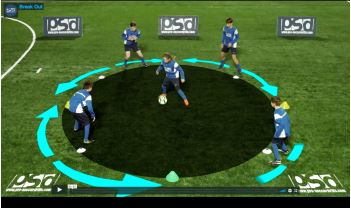The Importance of Triangle in Soccer
Basics
Triangles are the most commonly used shapes in soccer and these appear almost everywhere on the soccer pitch. Triangles consist of three edges and three vertices so it is easy to imagine for soccer players starting from younger age. This is why triangle shapes are easier to teach than any other shapes.
Triangles help and may improve the short-passing game because players can position themselves using a common idea so their game will be faster and may be more spectacular as they know where their teammates are. This improves their decision-making and their forward-thinking. Short-passing game is a requirement for every youth team and every youth team player and it is a good idea to teach the players through triangles.
Triangle Passing With Defenders
Diagonal passing is a great way to adapt fast, short-passing game. Diagonals are not horizontal nor vertical lines on the pitch but both of them. This is how most of the teams build-up their attack, keep possession in the midfield and break through the defence.
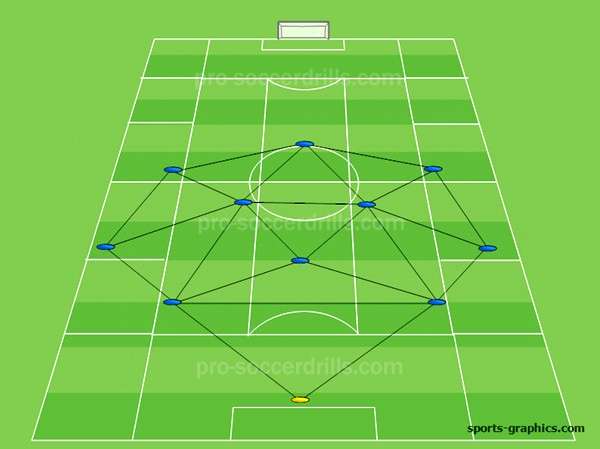
In this picture we can see a 4-3-3 formation in attack. The pitch is stretched so it is the best possible positional system to keep possession. The pitch is divided horizontally and vertically into zones: there are 5 vertical zones: 2 wing zones, 2 half-spaces and a centre (middle) zone. As it can be seen, half-spaces are for organiser players who play vertical passes most of the times. Only the wing zones (flanks) are divided horizontally. These zones can help the players position themselves into the right area.
We can also see many triangles in this formation and almost every angles are less than 90 degrees. These acute angles make the passing (one or two touch passing) easier for the players. The less touches a player make on the ball the more probable that the opponent can’t get close and tackle. This will make the opponent keep moving and the game will be faster.
Break the Defending Line with Deep Penetrative Run
Roles and Principles in the triangle shape
As every triangle has three edges consist of players on the pitch, we can give them different roles either in attack and defence.
We call these roles:
Pressure
Cover
Balance
Every player should follow different principles in every role. Pressure player is always the player nearest to the ball (or on the ball). The cover is the player nearest to the pressure player and the balance player is the player that shapes up the triangle. Let’s separate the roles in attack and in defence.
Triangles in attack
If the pitch is divided into zones (rectangles) then every player has the chance to position themselves into a different zone. This will create triangles and options for diagonal passing. This is how most of the youth teams get forward as this requires fast thinking and future vision from the players.
As we discussed, triangles have three roles and this appears in attack, too.
There is a Pressure player who is now the player on the ball.
He is helped by a Cover player who is the nearest teammate and must be able to be played (even if it is a passing option backwards).
Then there is the Balance player in the triangle who is the destination player. He should be the player that is going to have the ball to get forward.
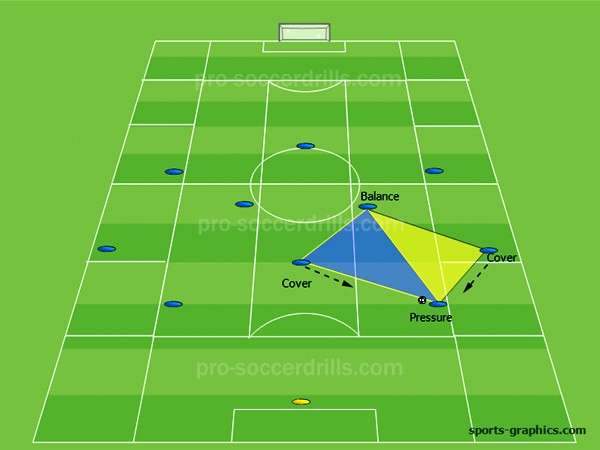
We can see that the right centre back is on the ball. He has two triangles to choose from. Because of these options there are two cover players. At least one cover player should always go towards the man on the ball to show himself for a short pass. The one that approaches should be played. The other cover can become the balance player, too. It always depends on the actual situation but roles should be given every time. Balance player in the picture is the destination player. If he could be played the ball instantly with a vertical pass (as it was mentioned before – players in the half-space give the most vertical passes) then he becomes the pressure and so on. Roles change after every pass.
Now we show you an exercise that is a little bit harder but shows clearly the roles in attack in the triangle game: 3v1 Possession Changing Sides
Later on we are discussing how to teach the triangle-game in attack, but first, let’s see what roles do we have in defence.
Roles in defence
The same three roles appear in defending in a triangle:
There is a Pressure player who puts pressure on the player on the ball
There is a Cover player who covers the space behind the Pressure player. So the cover player is the nearest teammate to the pressure player. He should be covering the area between the goal and the player on the ball. The distance shouldn’t be more than 6 metres in defence.
There is a Balance player who balances the triangle and closes the vertical passing lanes.
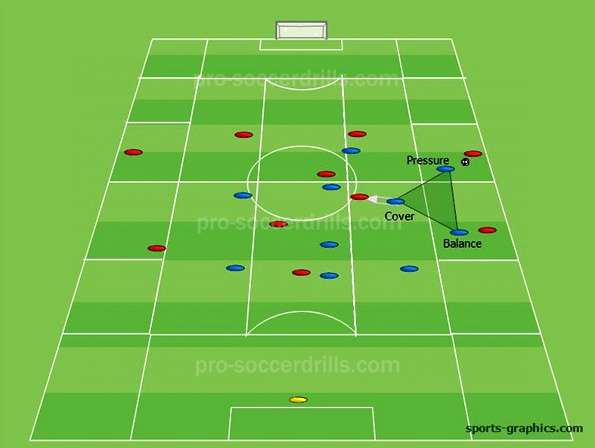
We just highlighted one triangle now but it is easy to demonstrate the triangle-roles through this picture. Cover player shouldn’t leave his player alone but he should keep the maximum 6 metres difference from the teammates. Balance player is taking care of the vertical pass and gives the cover player more freedom in defence as he defends space, not only marks a man.
Construction and destruction of triangles
There are situations when positional play is not enough to be effective so players need to leave their positions sometimes. But when should they do so?
Imagine a 2v1 situation against a single defender in the opponent’s half. Do your players have to interchange and leave their positions? Does the man without the ball have to make an overlap? If he does so, that will take more time than just keep his position and wait until the man on the ball decides between passing and dribbling. So when there is an overloaded situation (in other words numerical superiority) around the ball there is no need for interchanging movements. The same applies for a 3v2 situation when the ball is at the middle player’s foot. (If the ball is at a wing player in a 3v2 then there could easily be a 2v2 around the ball, so that’s not a numerical superiority.)
3v2 Shape Construction and Destruction to Maintain Possession
If there is no numerical overload in the surroundings of the ball then there has to be something happening. In a 3v3 situation for example there is a need for interchanging movements. Imagine a triangle and a 3v3 situation in it. Then players need to leave their positions and pick up another one. This is called shape destruction. The position he will be in should be another triangle as it makes the passing play easier. This is called re-construction or just simply construction of a shape. Triangles should be the starting shape and should be the finishing shape.
When and how to teach triangles for youth players?
At about the age of 10, young players should understand shapes and roles on the pitch. This is the time when they realise that it is easier to play the ball instead of just dribbling it and doing it solely. This is the age when their cognitive abilities make it possible to understand triangles. They not necessarily need to see more than 2 teammates. After they understood the roles and principles of the triangles they will be able to play the short-passing games going forward step by step.
Take a look at following drill: Roles After Losing the Ball
The four-goal game is played 3 against 3 so there is a huge probability that triangles can be seen without intercepting the kids’ game. There are goal-scoring zones either 5-6 metres apart from the goal line. There are 2 goals for each teams to score into so it is recommended to play horizontally fast. This is why Balance players are needed in this game. He keeps distance as the ball is faster than any players.
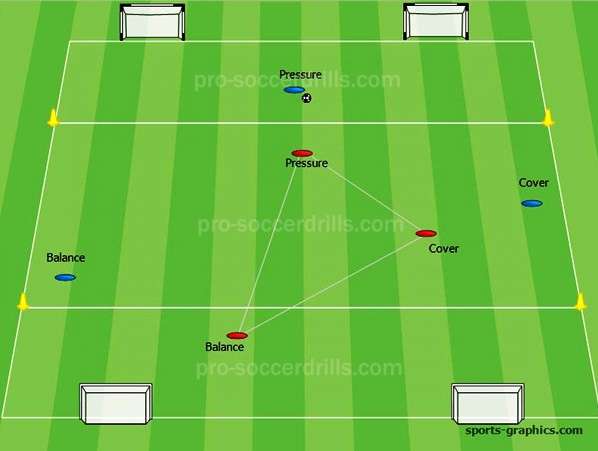
In defence the triangle roles will also appear as there should be always a balance player who takes care of the vertical pass (this means the goal).
There are many variations of the four-goal game but it is a great way to get the players understand the importance of the triangles on the pitch. It is also great because every player can step into the scoring zone and score. As there are only 3 attackers against 3 defenders, there might be an unbalanced pitch so 1v1s are also probable.
Summary
Triangles appear everywhere on the pitch. There is no need for 3 players to create a triangle. This may sound strange but a simple wall pass (one-two) can be seen as a triangle, too. A wall pass can make the attacking game faster as both players (passer and receiver [pressure – cover]) think the same way. Fast thinking can lead to fast plays. Common thinking can lead to a better understanding and a unity.
Free Trial
GET YOUR FREE 14 - DAYS TRIAL NOW! INCLUDING:




